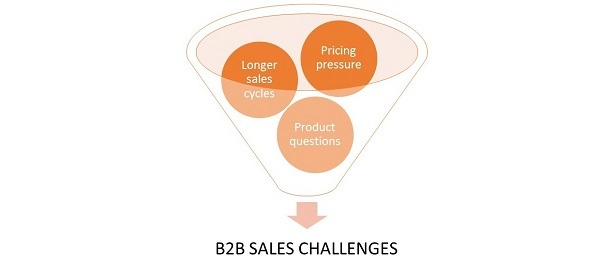
 The past four blogs have discussed the different reasons decision makers choose to buy products and services, and just one final area remains to be analyzed as part of this series. On the surface it seems obvious: the ability of the salesperson to convince the buyer to actually buy their product.
The past four blogs have discussed the different reasons decision makers choose to buy products and services, and just one final area remains to be analyzed as part of this series. On the surface it seems obvious: the ability of the salesperson to convince the buyer to actually buy their product.
First, it is important to define sales effort. In a typical win / loss program, feedback is garnered across a number of sales attributes such as the salesperson’s responsiveness and rapport building with the prospect, their ability to conduct needs analysis and customize the presentation to the prospect’s unique needs, and ultimately make the prospect feel like an important client.
After looking at thousands of Win Loss Analysis interviews from the past year, sales effort was noted as a reason for choice in 11% of Mature market and 17% of Emerging market decisions. These frequencies may seem low, but they emphasize just how important Win Loss Research is to understanding business choices.
17% was actually the second-highest percentage amongst reasons for choice in Growth markets, bringing to light how complex decisions in these industries can be. There is never a predictable answer that is standard across these deals, and although it is critical for sales teams in these markets to effectively articulate their company’s value proposition, according to the data shared with us, most of the time they fall short.
Now consider the Mature market, where sales effort was only noted by 11% of respondents. In the more commoditized spaces, the significance of sales effectiveness on winning a deal is intensified. Salespeople need to be able to differentiate from the rest of the market, but ultimately the 11% figure demonstrates their ability to do so is not very high.
If you remember that one-fifth of all decisions in Mature markets involve a previous relationship, not only are sales reps in these spaces selling against analogous competitors but also against strong incumbent ties. While these binds may be deflating the sales approach as a reason for choice number (because some prospects are averse to changing providers due to switching costs and pains, even if a competitor outsold them), they reemphasize how essential it is for sales reps to raise their game.
A win / loss program is an essential tool to understanding sales effectiveness because it arms executives and sales teams with the data, feedback, and suggestions needed to become more effective. In the past year, 75% of Anova’s clients did just that, improving the frequency in which sales was mentioned by prospects as a reason for choosing them in bids won situations compared to the rate in their previous program. Sales teams across all types of industries struggle with sales effectiveness, and this kind of research can give them a leg-up when trying to win more business.
This concludes the 5-part series investigating buying decisions across Mature and Growth markets. For a recap of past analysis, below are the links to the articles.
Note, this is Part 4 of Anova’s 5 part series: Understanding Decisions. For an overview of the research methodology, Click Here. Be sure to come back at the end of the month for the last post examining sales effort.

Win / Loss analysis brands
Brands are everywhere around us. In markets driven by consumers, a brand can be a powerful differentiator and the reason someone might choose to drink Coke instead of Pepsi, or drive a BMW instead of a Mercedes. In the B2B world however, the importance of brand can be less clear.
Does a decision-maker weigh the impact of brand equity when signing off on a premium product over a less-expensive option? Will the owner of a small business factor in the notoriety of using the software from a prominent technology vendor instead of a less-known start-up which offers a more advanced user interface?
Here’s what we do know: Brand was mentioned as a reason for choosing a vendor twice as much in Mature market situations (33%) than in Growth market decisions (16%). Why would brand be seen as twice as important in these more established industries?
In the financial services world, buyers are more likely to choose a provider with a trusted brand. Longevity, stability, and organizational strength all make a person feel safe and protected so that he may turn over his assets. Even when you look at the dictionary definition of the names of some leading financial services companies you find: faithfulness, loyalty, the ability to make someone stronger, leading in new ideas, act in confidence. These names are designed to promote trust and confidence, and when we look at the data and see 1/3rd of all decisions from Mature markets include brand in some capacity, it is evident emotional ties are important.
Anova’s Mature market classification does not include all financial services companies, however. There are other corporations we included who exist in markets in which the competitive landscape is stable and market share is largely held by only a few select providers. In these scenarios, market leadership and the widespread reputation as a top provider is often cited as a reason for selecting those companies.
On the flip side, Growth markets can be too fast-moving for brands to really take hold and factor into decisions. Disruptive new products or M&A activity leads to ever-changing marketplaces. In these Growth market decisions, it is not uncommon to see a smaller company with breakthrough technology take on a large conglomerate and win a deal. While 16% of buyers do end up choosing a vendor based on their reputation, without the same need for trust that Mature market buyers have, Emerging market decisions largely do not involve brand.
A company’s brand can distinguish itself as unique but it doesn’t always influence final buying decisions. In Anova’s research, brand was twice as important in final purchase decisions in Mature markets, largely due to the importance of stability and reputation in the financial services arena. In Growth areas, the constant transforming of the competitive landscape upends the ability for brands to resonate deep enough in buying decisions.
 Note, this is Part 3 of Anova’s 5 part series: Understanding Decisions. For an overview of the Win Loss Research methodology, Click Here. For Part 2: Exploring the Influence of Price, Click Here.
Note, this is Part 3 of Anova’s 5 part series: Understanding Decisions. For an overview of the Win Loss Research methodology, Click Here. For Part 2: Exploring the Influence of Price, Click Here.
Trust. It’s the backbone of friendships and relationships, but not all business partnerships. In fact, Anova found that the trust built from a positive past experience can be influential in many Mature market sales situations, but did not play a role in decisions within Growth markets. Ultimately, a fundamental distinction in how each of these markets are constructed leads to this difference.
When we looked at reasons for selecting a vendor in Growth markets, a prior relationship was only mentioned by 4% of all respondents. Growth markets, by Anova’s definition, are dynamic industries heavily influenced by disruptive providers bursting onto the scene offering new products and technologies. There is little opportunity for a prior experience to even exist, as there always seems to be a new competitor with a more advanced product or innovation. In these fast-moving arenas, legacy relationships are not weighted as heavily in final decisions. Decision-makers, in turn, value innovation, efficiency gains, and the ability to actually accomplish a specific organizational need. Imagine the complexity here for sales organizations selling in these markets – each sale is like starting a new relationship, and it takes a lot of effort to build trust with the prospect. Our research found the sales effort in this market was a leading criteria for choosing a product, second only to the product features. The takeaway: salespeople in Growth industries need to put forth a stronger sales effort during the actual sales process to compensate for the lack of a pre-existing relationship.
In Mature markets, however, a positive past experience with the winning provider was cited 22% of the time. This is a substantial difference between the two markets. The main reason for this is trust. Renowned author Stephen Covey acknowledges this attribute in saying, “When the trust account is high, communication is easy, instant, and effective.” Mature market sales teams are more likely to have the benefit of a past relationship to aid the effectiveness of their sales efforts.
While disruption defines the Growth market, the Mature market is largely made up of financial services organizations and more stable enterprises. When managing a person’s financial status or handling his money, particularly his hard earned savings, trust is paramount. Mistakes are not only costly, but personal. There needs to be a high level of conviction and even comfort that the hired vendor will provide the service and integrity sought. Often times, this confidence felt by the decision-maker comes from having worked with the vendor before in a positive, trusting way.
Trust resulting from an existing or prior relationship proves to be the second-largest delta amongst reason for choice mentions – an 18% difference. While Mature markets recognize the comfort of working with a past relationship during sales opportunities, research does not show the same for Growth markets. In either case, though, both markets need to build and sustain trust with new and existing clients in order to retain their own client base.
In the next post we will explore how brand can be influential between the Mature and Growth Markets.
For Immediate Release
Contact:
Andrew Cloutier
Anova Consulting Group, LLC
(617) 731-1045
andrew@anovaconsulting.com
Brookline, MASS. October 18, 2016 – Anova Consulting Group, a leading provider of Win Loss Research and Win / Loss analysis and client retention analysis to industry leading financial services, technology, and healthcare companies announced the addition of Jack Ryan as a research analyst.
Prior to joining Anova, Jack gained work experience at Standish Management and Gurnet Consulting. He is a graduate of Williams College, where he earned a BA in Economics and was recognized for his leadership as a four-year letterman on the Williams football team.
Jack will be focused on the day-to-day execution of Anova’s custom market research programs, as well as analysis of aggregate program data to identify actionable insights for clients. He will cover clients in the financial services, enterprise technology, and healthcare market verticals.
“In the competitive and rapidly changing markets that Anova covers, we are experiencing ever-increasing client demand for more information in a faster timeframe,” said Richard Schroder, president of Anova Consulting Group. “Jack brings an impressive analytical background and a strong work ethic to our team, which will help Anova continue to deliver top-quality research to our expanding client base.”
Jack will report directly to Andrew Cloutier, Partner at Anova.
ABOUT ANOVA CONSULTING GROUP, LLC
Established in 2005, Anova Consulting Group is a leading market research and consulting firm focused on Win / Loss research and client retention analysis. By helping its clients understand why they win, lose, and retain business, Anova provides strategic perspectives driving better decision making, product development, sales effectiveness, client service, and continuous improvement. Richard Schroder, Founder and President of Anova, is author of a book titled From a Good Sales Call to a Great Sales Call (McGraw-Hill), which details how learning from post-sale debriefing helps close more future sales.
 “Price is what you pay. Value is what you get.” Said by famed investor Warren Buffet, this quote draws distinctions between different components of cost. But how does this expression from one of the world’s wealthiest men play out when considering buying decisions made at the conclusion of a traditional B2B sales process?
“Price is what you pay. Value is what you get.” Said by famed investor Warren Buffet, this quote draws distinctions between different components of cost. But how does this expression from one of the world’s wealthiest men play out when considering buying decisions made at the conclusion of a traditional B2B sales process?
Anova’s research reinforces Buffet’s assertion. Ultimately, price dominates decisions in Mature markets twice as frequently as decisions in Growth markets. In our research over the past year, cost was mentioned as a reason for choosing a provider 59% of the time in Mature markets, and 29% for clients in Growth markets in our Win Loss Research.
What is behind this 30 point difference? In Mature markets, competitors are selling a similar product or service. The relatively indistinguishable product means buyers do not have to worry about a difference in utility – in other words, one product or service would “work” as well as the competitor’s product or service. Buyers put a greater emphasis on minimizing fees or cost in order to gain the most value. How does a firm win in these situations? Fee compression takes hold and vendors offer lower prices.
In order to illuminate this, think of an example from the group insurance space. ABC Corporation wants to offer the best possible benefits plan at an affordable cost to their employees, and goes out to market to compare bids from a few insurance providers. When the proposals come back all of the plan features are roughly the same. Insurance Company X, however, has discounted their plan 20% less than Insurance Company Y. Company X knows that since their benefit offering will be similar to their competitors, they need to squeeze their margins in order to differentiate themselves. ABC Corporation sees the two plans as substitutable, and in this situation, Company X’s ability to use lower costs as a competitive advantage wins them the plan.
Conversely, research in Growth markets shows something much different. In Growth markets, there is often a greater difference in the utility derived from two competing products. Think of this example: ABC Corporation is now looking into business intelligence software to streamline its manufacturing processes. Software Company X offers a low-cost product, but with minimal functionality and management portals that are difficult to navigate. Company Y, on the other hand, allows users to view the throughput times of their manufacturing process at a number of different facilities across the country and monitor the productivity of different teams, all on an easy to use dashboard. Even if Y’s software is more expensive, the value gained outweighs the costs, and (unless ABC Corporation is budget-strapped) will most likely be chosen. In this decision, however, functionality and ease of use will be cited as reasons for choosing Y, not price.
While price is the most frequently cited reason for choice in both Mature and Growth markets, it is not the sole decision criteria in competitive situations. Other factors need to be explored. In our next blog post as part of this Reason for Choice Series, we will further investigate the level of impact a previous relationship with a vendor has on a buying decision.
 How much is one sales meeting worth to your business? This past weekend, the NBA’s Golden State Warriors successfully pitched superstar Kevin Durant to join their already-impressive roster led by reigning two-time MVP Steph Curry. Having both players is a huge advantage for Golden State, but the two could have also been part of another team: the list of athletes sponsored by Nike. Instead, Curry’s rise to fame has been all while donning the Under Armour logo on his shoes and clothes, leaving Nike officials to ponder how he got away. Curry’s story parallels much of what Anova finds in our past decade of B2B Win Loss Analysis. The lesson learned: Implementing a Win / Loss analysis program to conduct post-sale debriefs leads companies to be better positioned to improve future sales performance.
How much is one sales meeting worth to your business? This past weekend, the NBA’s Golden State Warriors successfully pitched superstar Kevin Durant to join their already-impressive roster led by reigning two-time MVP Steph Curry. Having both players is a huge advantage for Golden State, but the two could have also been part of another team: the list of athletes sponsored by Nike. Instead, Curry’s rise to fame has been all while donning the Under Armour logo on his shoes and clothes, leaving Nike officials to ponder how he got away. Curry’s story parallels much of what Anova finds in our past decade of B2B Win Loss Analysis. The lesson learned: Implementing a Win / Loss analysis program to conduct post-sale debriefs leads companies to be better positioned to improve future sales performance.
In a recent ESPN article, reporter Ethan Strauss unveiled details of the courtship for the reigning 2-time NBA MVP Curry by top sponsors Nike and Under Armour. Readers learned the cringe-worthy story of how one of the most iconic sports brands in the world lost an athlete worth an estimated $14 billion to one of their top competitors. However, readers may not have fully realized the similarities between Nike’s mistakes and the ones that occur in their own companies’ sales situations. Through the hundreds of Win / Loss interviews Anova conducts each month, trends of similar sales miscues emerge across all industries and deal sizes. Some mistakes are more prevalent than others, but all are avoidable. Let’s take a closer look at how Nike made several common sales mistakes and turned off one of their most promising young stars:
In 2013, Nike met with Curry, a current client at the time, in order to sign him to a contract extension. There was no reason why they shouldn’t have been able to; Curry had been wearing the iconic swoosh on his sneakers his entire life and on top of that, Curry’s godfather was an employee of the Oregon-based company. Still, Nike faltered when it was time to meet with Curry. Instead of bringing their top brass, Nike chose to not include one of their chief athlete advisors who had worked with other basketball stars such as LeBron James. The lack of executive attendees signaled to Curry that Nike did not feel he was important enough to warrant the heightened attention.
Anova has learned by conducting thousands of win / loss interviews that making a prospect feel valued is one of the most important drivers of a winning sales process. In the Curry situation, Nike started off on the wrong foot by not having the right personnel at the sales presentation and compounded the issue by not customizing the pitch properly. Included within Nike’s PowerPoint was a slide with Kevin Durant’s name instead of Curry’s, a sloppy error suggesting the presentation was merely reprocessed material used for another Nike athlete. Adding insult to injury, one Nike official was said to have mispronounced Stephen’s name. Between the recycled PowerPoint and calling Curry by the wrong name, Nike failed to make their client feel valued.
The inability to make a prospect feel important is consistently one of the top sales weaknesses cited by respondents in Win / Loss surveys. In this case, it cost Nike considerably. A failure to understand and address fundamental sales issues can be the difference between winning and losing a key deal, yet it still amazes heads of sales that these mistakes are occurring within their sales teams. In 2015 alone, Anova identified ineffective sales performance as a reason for losing bids in almost 50% of situations!
The real question is: How much is it costing your organization to make the same mistakes as Nike?
 We live in a world consumed by data and analytics. Technology has allowed us to track and measure just about every activity in our lives, both personal and professional. We have the opportunity to gather data and use it to understand our decisions, efforts, and subsequent outcomes. But does it always have to come down to a cold, hard number? What about the experience behind the numbers?
We live in a world consumed by data and analytics. Technology has allowed us to track and measure just about every activity in our lives, both personal and professional. We have the opportunity to gather data and use it to understand our decisions, efforts, and subsequent outcomes. But does it always have to come down to a cold, hard number? What about the experience behind the numbers?
Enter the art of conversation. Through one-on-one interviewing, research opens up and goes beyond the numbers and metrics. In-depth interviewing allows the experience to truly be heard… it tells the story behind the metrics.
Anova’s service offering aims to capture the entire experience – the metrics (hard data and analytics) as well as the open-ended commentary shared by the interviewee. Whether it be a Win Loss Analysis, Post-Implementation, Client Satisfaction, or Departed Client scenario, the interview is designed to go into the specifics and reveal the details that metrics may not be able to capture. These aspects include preferences, attitudes, tone, biases, and competitive comparisons. Simply put, the conversation says what numbers cannot.
The art of conversation is at its best when an interviewer is able to probe effectively. For example, although the interviewer begins every discussion armed with a customized questionnaire template, what often takes place is not a simple Q&A, but rather a deeper, richer conversation. Anova interviewers are trained to transform what may be initially a nondescript answer into a more detailed response by asking questions and probing such as:
The effectiveness of these probing questions are amplified when they are asked by an objective third-party. While a prospect or client may be hesitant to share details about their experience to someone with whom they have a relationship, often times they are more at ease revealing the unfeigned truth to a party understanding of their situation, yet not emotionally involved.
The customer’s voice plays an integral part in understanding and learning about the whole experience. That is why Anova’s reports not only present data and trends, but also support every finding with the interviewee’s verbatim responses during their conversation with our team.
Pure data offers one way to evaluate a single event, but when married to the art of the conversation, the research becomes more complete, and most importantly, more meaningful.
 The truth hurts. However, most people would agree that in order to get better at something, you must fully understand where and what you need to improve on… otherwise known as the brutal facts.
The truth hurts. However, most people would agree that in order to get better at something, you must fully understand where and what you need to improve on… otherwise known as the brutal facts.
It’s not just anecdotally. In his National bestselling management book Good to Great, Jim Collins dedicates an entire chapter to “confronting the brutal facts”. Collins substantiates that in order for companies to become great, they must be willing to learn the truth about what they are doing well, and more importantly, what they could be doing better. In fact, it is only after companies do this that they are able to hit an inflection point and begin the breakthrough process towards greatness.
Collins goes on to cite examples of corporations such as Pitney Bowes and Kroger who did not shy away from the brutal facts, but instead embraced hearing the truth about areas they could do better in; no matter how painful it felt initially. In the case of Pitney Bowes, senior executives encouraged their employees to come forward and tell them directly all of the issues clients had complained to them about. They were unafraid of hearing some of the searing commentary because they knew they would be better for it. The leadership team at Kroger made the tough decision to re-strategize their entire business model because they did not shy away from the facts of the grocery store industry changing beneath their feet. The result? Surpassing their competitors and becoming one of the preeminent consumer stores of the late 20th century (the book was published in 2001).
The organizations in Collins’ study that were deemed the most successful were ones who yearned to hear the brutal truth about their efforts while simultaneously having the conviction to know that they would be better for it. Why then, do so many people run from feedback on where they could be doing better?
In Anova’s experience, too often managers are worried the sales team and other members of their organization will resist the feedback if it is not positive. They decide to not collect data on how their company could improve because they are worried employees will view it strictly as an evaluation mechanism designed to judge their performance instead of a process to help them improve it.
On the flip side are companies that understand feedback does help. These companies seek the unbiased, unfiltered, “voice of the client” commentary on why their organization is winning and losing. These companies take the data collected, reflect on the findings, and implement real changes to try and fix potential issues. In 2015, 60% of Anova’s Win Loss Analysis clients saw a decrease in the frequency of mentions of their #1 area for improvement from the year before. These are organizations who have realized that in order to become more competitive, they must first hear what they could be doing better. These companies have accepted feedback as a major driver in organizational improvement. In the eyes of Jim Collins, these are great companies.

SalesForce knows a thing or two about selling B2B. So when Marc Benioff, CEO of SalesForce, talks about the challenges facing enterprise sales, we tend to listen. Here’s what Benioff said in the latest annual report for SFDC about the headwinds facing his own company:
“As more of our sales efforts are targeted at larger enterprise customers, our sales cycle may become more time-consuming and expensive, we may encounter pricing pressure and implementation and customization challenges, and we may have to delay revenue recognition for some complex transactions, all of which could harm our business and operating results.”
These challenges are familiar to any company selling to other businesses. As markets evolve and selling becomes increasingly challenging, sales leaders are searching for an added advantage to give their business the edge it needs. With that in mind, here is how a Win Loss Analysis program can help combat the challenges laid out above:
Longer Sales Cycles Requiring More Investment: Heads of sales are committing more dollars and more human capital towards growing sales. There is no better way to protect an investment in a sales force than by arming them with the intelligence they need to elevate their game. The feedback into what works, what doesn’t work, and what sales strategies other vendors are bringing to the marketplace is invaluable for any sales representative in today’s landscape. Anova estimates that less than 20% of U.S.-based companies utilize Win Loss Research as a feedback mechanism, making the knowledge gained through a formal program a notable competitive advantage.
Pricing Pressure on Products / Services: Whether it is a new or an established product line, prospects will almost always factor in costs to their buying decision. Win Loss Research specializes in extracting pricing information about all competitors and products in the market, and assesses how individual competitors’ value propositions are perceived by customers.
Product / Implementation Questions: Are the product features effective? Is the interface user friendly? Is the implementation process effective enough to get clients up and running in the timeframe they need? Are our clients having buyer’s remorse? These are all questions that impact client satisfaction and retention, and ultimately keep executives up at night. The open-ended Voice of the Client feedback captured in Win Loss studies has proven invaluable to business leaders as they launch new product lines or are checking in on existing services.
A Win Loss study isn’t a magic antidote to sales issues, but can be an effective tool in helping business leaders understand how their prospects perceive their company. In a recent study, Gartner estimated that a comprehensive program can increase win rates up to 50%! Given today’s challenging sales environment, the question shouldn’t be Why Win Loss Research? It should be How soon can we begin?
Welcome to the Anova Consulting Group Blog! Here at Anova, we pride ourselves in our Win Loss Analysis work helping companies understand why they are winning and losing business and how they can be more competitive in their respective marketplaces. Although our time is mostly spent working closely with our clients and focused on our research, we also have a lot of interesting thoughts that we would love to share with the rest of the world. Hence the birth of this blog.
The idea of this blog is to share industry trends, business perspectives, and even current events, all with a twist relating back to the core principles of our work: gathering feedback, making strategic decisions, becoming more competitive, etc. There may even be the occasional movie or book review, but we promise to keep the topics captivating and insightful. Remember to check back in frequently, and if you are not familiar with us, take some time to poke around the website and meet the Win Loss Research team.
We thank you and encourage any feedback or ideas you are interested in hearing our take on!